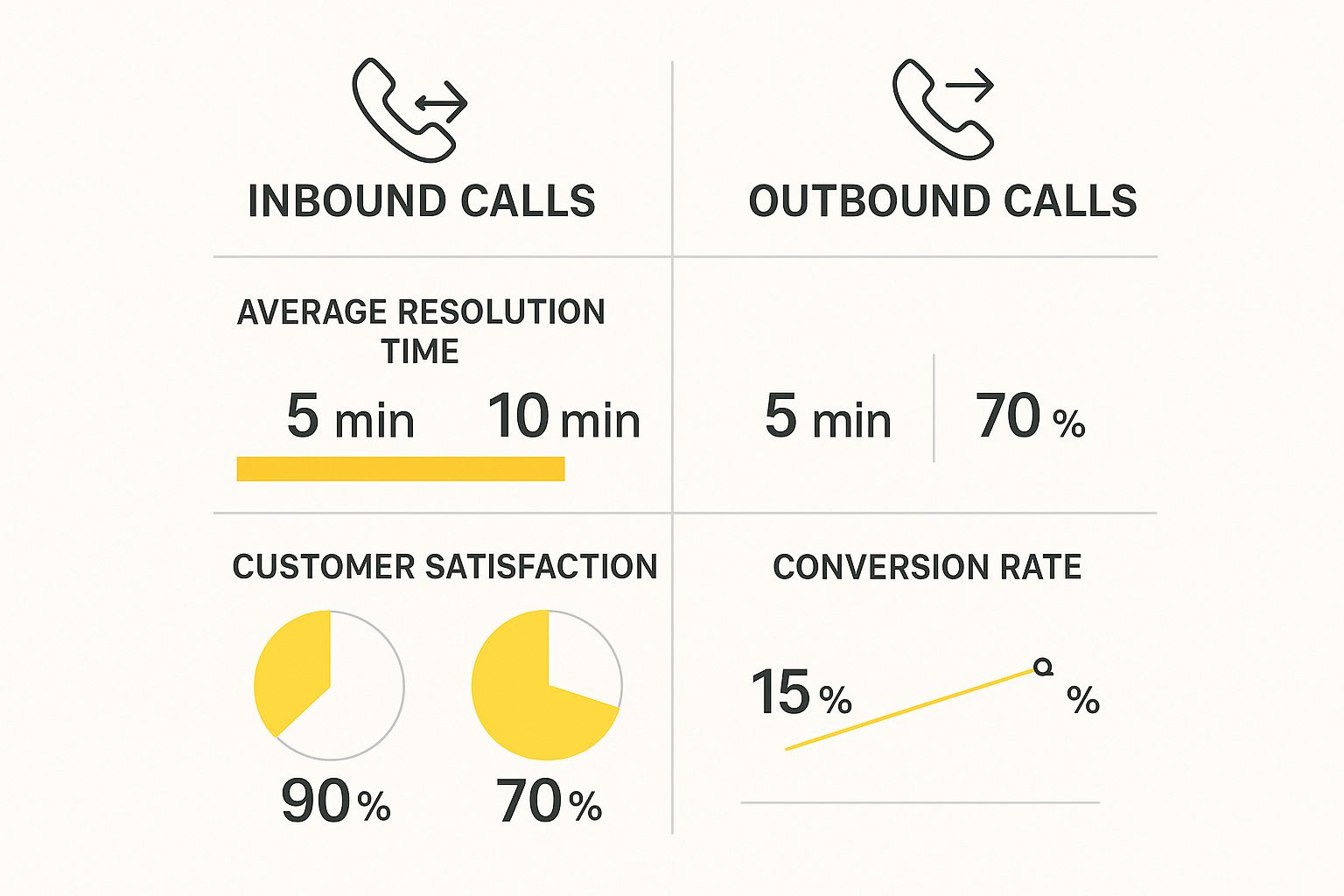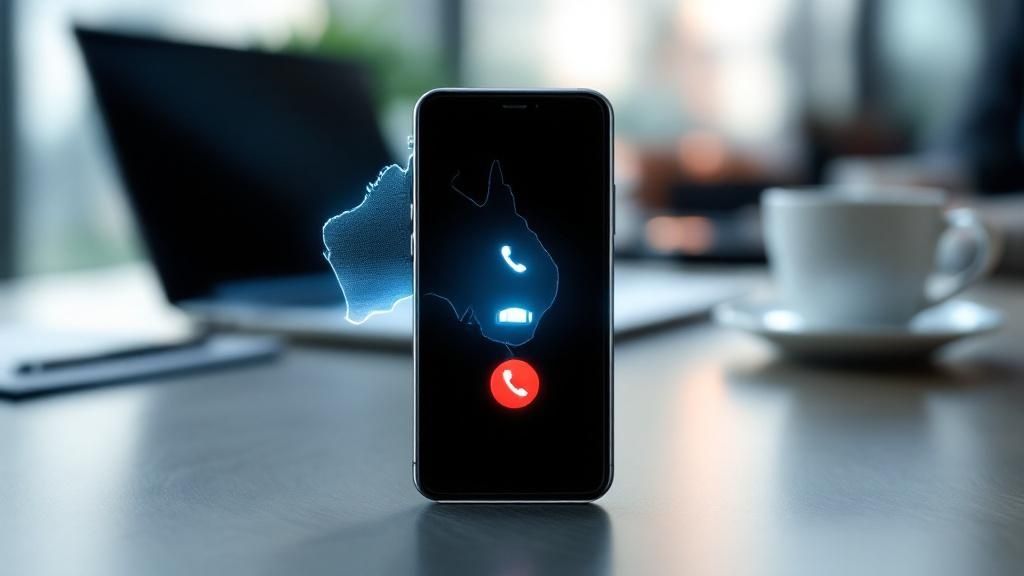On the surface, an inbound call is simply a phone call that a customer makes to your business. Simple, right? But that’s just the dictionary definition.
Unlike outbound calls where you’re the one reaching out, an inbound call means a customer has a specific need—right now—and they’ve actively chosen you to help solve it.
What Inbound Calls Really Mean for Your Business

Let's move past the textbook stuff. A ringing phone isn't just a noise; it's a customer actively seeking you out. Think of it like someone walking directly into your shop—it shows real interest and gives you a golden opportunity to help, make a sale, or build a lasting relationship.
This shift in perspective is everything. When you stop seeing these calls as interruptions and start seeing them as customer-driven opportunities, you begin to transform your entire approach to service. Each call is a direct line into your customers' wants, frustrations, and needs.
The Voice of the Customer
Every single inbound call is a window into what your customers are really thinking. These aren't just transactions; they're goldmines of unfiltered feedback. They can tell you a lot, such as:
- Product or Service Issues: Customers often call when something isn’t working the way it should, pointing you directly to areas that need a fix.
- Sales Opportunities: A call asking about features or pricing is a hot lead knocking on your door, ready to be converted.
- Customer Sentiment: The tone and topics of your calls are a real-time gauge of how happy (or unhappy) your customers are.
Here in Australia, you can't ignore how important this is. Inbound calls are the main way customers get in touch with contact centres, making up around 66% of all inbound volume. This shows that even with email and web chat, people still prefer a direct, real-time conversation. You can explore more on this topic to get a better sense of Australian call centre trends.
An inbound call is a moment of truth. It's an interaction where a customer's perception of your brand can be either solidified or shattered, often in just a few minutes.
Ultimately, truly understanding the inbound call meaning is about recognising the huge value packed into every conversation. By getting the fundamentals right, you can turn your customer service from a simple cost centre into a powerful engine for growing your business.
Inbound vs Outbound Calls: What’s the Real Difference?
Getting your head around the difference between inbound and outbound calls is a game-changer for any business. Think of it like a physical shop: an inbound call is a customer walking through your front door, while an outbound call is you going out and knocking on theirs.
This simple distinction changes everything. One is reactive—it’s driven by a customer who has an immediate question or problem they need sorting. The other is proactive, driven by your business goals, like chasing a lead or getting feedback.
This infographic lays out just how much these differences matter when it comes to performance.

As you can see, inbound calls pretty much always lead to higher customer satisfaction and better conversion rates. It makes sense, right? The customer has already decided they need you.
Different Goals Mean Different Game Plans
Because the customer's mindset is totally different, inbound and outbound calls are used for completely separate things and require unique skills.
-
Inbound Calls Focus: The name of the game here is helping people. Your team needs to know your product inside and out, be empathetic, and have top-notch problem-solving skills to handle everything from support queries to enquiries from keen prospects.
-
Outbound Calls Focus: This is all about initiating the conversation. It’s for tasks like sales prospecting, setting up appointments, or doing customer surveys. The agents on these calls need to be resilient, persuasive, and able to build a connection from a cold start.
You wouldn't use a hammer to turn a screw. In the same way, using an outbound, salesy approach for an inbound support query—or vice versa—is a surefire way to annoy customers and miss out on big opportunities. Each call type needs its own specialised approach.
A one-size-fits-all strategy just won't cut it. The tech, the training, and the way you measure success are fundamentally different for each. If you're keen to dig deeper, you can get more details on the differences between inbound and outbound calls in our full guide. Nailing this distinction is the first step to building a communication system that actually works for your business.
Why Inbound Calls Are Your Business Growth Engine

If you're still thinking of inbound calls as just a support function, you're missing a massive opportunity. The reality is, every time your phone rings, it's a direct line to business growth. These calls are way more than admin tasks; they're priceless, unfiltered conversations that tell you exactly what your customers need and want.
When a customer picks up the phone to call you, they're already highly engaged and motivated. This turns every single interaction into a golden chance to not only fix a problem but to build some serious loyalty. A great support experience can easily turn a frustrated customer into your biggest fan.
Unlocking Hidden Revenue and Insights
Beyond just building loyalty, inbound calls are a straight-up source of revenue. A simple question about a product can quickly flip into a sale, and a support query might reveal a perfect moment to upsell a customer to a better solution that really nails their needs. Your team is in the perfect spot to catch these moments.
These conversations are also the best market research you'll ever get. Customers will tell you exactly where your products are falling short or what new features they’d happily pay for. This direct feedback is your secret weapon for staying ahead of the competition and making smarter business decisions.
An inbound call isn't an interruption to your work; it is your work. Each call is a chance to deepen customer relationships, gather critical business intelligence, and drive tangible growth.
The Australian Context for Inbound Demand
Here in Australia, understanding what drives people to call is key. Think about how broader economic trends, like tourism, directly fill up the phone lines for call centres. In the year ending March 2025, Australia saw a massive 7.7 million international trips. That’s a huge increase, and it fuels demand for support in travel, hospitality, and everything in between. It just goes to show how external factors can load your phone lines with high-value enquiries.
Handling these calls effectively isn't just a nice-to-have; it's non-negotiable. Missing a call from a potential customer is like slamming the door in the face of a sale. To really get your head around this, you can learn more about the impact of missed calls on lead generation.
This is exactly where services like OnSilent come in. We're designed to make sure you never miss these critical opportunities, helping you capture every single lead and manage customer interactions without anything slipping through the cracks.
How to Measure Inbound Call Success
If you're not measuring your inbound call performance, you're flying blind. It's easy to have a gut feeling about "good" customer service, but real improvement comes from tracking specific, actionable numbers. This isn't just about collecting data; it's about seeing the story your numbers are telling.
To really get a handle on what's working, you need to be across the right performance indicators. You can deep-dive into all the essential call center metrics, but for now, let’s focus on the big ones that give you a direct window into efficiency and customer happiness.
Key Metrics You Can't Ignore
Three core metrics will give you a powerful snapshot of how things are really going.
-
Average Wait Time (AWT): This is simply how long your customers are stuck on hold before a real person picks up. Long wait times are a one-way ticket to frustration and abandoned calls, which costs you leads and chips away at your reputation.
-
First Call Resolution (FCR): What percentage of calls get sorted out on the very first try? A high FCR is a brilliant sign that you have a capable, knowledgeable team, and it's a massive driver of customer satisfaction. No one likes calling back.
-
Customer Satisfaction (CSAT): This is your direct feedback loop. Usually, it's a simple post-call survey asking customers to "Rate your experience from 1-5". It tells you exactly how people feel after talking to you.
Keeping an eye on these metrics isn't just an internal box-ticking exercise. It's about seeing your business through your customers' eyes. A long wait or needing to call back might feel like a small hiccup to you, but for them, it’s a major pain.
Just to give you a bit of a benchmark, the average wait time for customers in Australia was recently clocked at about 1 minute and 53 seconds—and that figure includes people who gave up and hung up! You can check out more details in this report on popular call centre metrics.
By tracking these key figures, you can spot weaknesses, set clear goals for getting better, and make sure your inbound call system is actually helping you grow instead of creating friction for your customers.
Tools and Strategies for Effective Call Management

Nailing your inbound call flow isn't just about picking up the phone. It's a careful mix of the right tech and a smart human touch. Think of it as creating a smooth, professional journey for every single caller, from the second they dial your number to the moment they hang up, happy.
Technology is your foundation here. It takes care of the repetitive stuff, freeing up your team to focus on what really matters—the customer. Tools like Interactive Voice Response (IVR), for instance, act like a super-efficient digital receptionist, guiding callers to the right department without anyone having to lift a finger. This doesn't just save time; it makes sure customers get straight to the person who can actually help them.
If you want to get a better handle on the tech that makes this possible, it's worth understanding what Interactive Voice Response (IVR) systems are. Another game-changer is Customer Relationship Management (CRM) software. This gives your team an instant snapshot of a caller's history, turning a potentially cold interaction into a genuinely personal one.
Essential Technologies for Your Toolkit
Modern businesses have a whole host of options to get their incoming calls under control. The real trick is to build a system that slots perfectly into your workflow, combining a few key tools to create a seamless experience.
- Intelligent Call Routing: This is your traffic controller. It automatically sends calls where they need to go based on the caller's needs, time of day, or who's available, making sure no call ever gets lost in the shuffle.
- CRM Integration: This connects your phone system to your customer database, arming your team with crucial context for every single conversation. It's the difference between "Who are you again?" and "Hi Sarah, how can I help you today?"
- AI Assistants: Think of services like OnSilent as your first line of defence. They can filter out spam, transcribe your voicemails, and manage missed calls, saving you a massive amount of time. It's incredible how powerful good call management software can be for a business.
People-Powered Strategies That Make a Difference
As great as technology is, it's only half the story. The human element is what turns a decent call into a fantastic one. That means you've got to invest in your team's skills and your internal processes.
Technology gets the caller to the right person. Strategy and training ensure that person provides the right answer.
Start by building a solid knowledge base—a central hub of information your team can pull from to answer questions confidently and correctly. This empowers them to solve problems on the first go.
From there, develop clear call scripts. These shouldn't be rigid, word-for-word instructions, but rather a consistent framework that still allows for natural, empathetic conversation. And finally, never stop training. Ongoing coaching in soft skills like active listening and creative problem-solving is non-negotiable if you want to build real, lasting rapport with your customers.
Got Questions About Inbound Calls? We’ve Got Answers.
Even once you get the hang of what inbound calls are all about, a few common questions tend to pop up. Here are some quick, straight-to-the-point answers to help you put these ideas into practice for your Aussie business.
What's the Real Goal When Handling an Inbound Call?
At its core, the main goal is to solve the customer's problem on the first try, and leave them feeling good about it. Whether they’re calling with a support issue, a sales question, or just a quick enquiry, you want them to hang up feeling heard, helped, and happy. That’s how you build a rock-solid relationship with your customers.
Can a Small Business Really Manage Inbound Calls Without a Full-Blown Call Centre?
Absolutely. You don't need a huge team in headsets to nail your customer communication. Small businesses can easily manage their inbound calls with simple tools like a dedicated business phone line, a VoIP system that can route calls, or even a virtual receptionist. The secret isn't size; it's having a smart process for who answers what and how you keep track of it all.
You don't need a massive call centre to deliver exceptional service. What you need is a smart, organised system that ensures every customer feels valued and every opportunity is captured.
Aren't Inbound Calls Just for Customer Service?
Not at all! Thinking they're just for support is a huge missed opportunity. Inbound calls are a goldmine for sales and marketing. When a potential customer calls you, that's one of the strongest buying signals you can get—they're actively interested. Even a call from a current customer can be the perfect moment to mention a new service that could make their life even easier.
How Can I Cut Down on All the Unnecessary Calls?
Look, you always want to be there for your customers, but fielding the same simple questions over and over drains your team's time. The trick is to empower customers to find answers themselves. You can do this by:
- Building out a really detailed FAQ page on your website.
- Giving them self-service tools, like an online portal to track their own orders.
- Making sure your product info is crystal clear from the get-go.
This way, customers get instant answers, and your team is freed up to handle the more complex, valuable conversations.
Stop letting important calls slip through the cracks. OnSilent works like your personal AI Call Assistant, filtering out the spam and organising your calls so you can focus on the stuff that actually grows your business. See how many hours you could get back each week by checking us out at https://onsilent.com.

